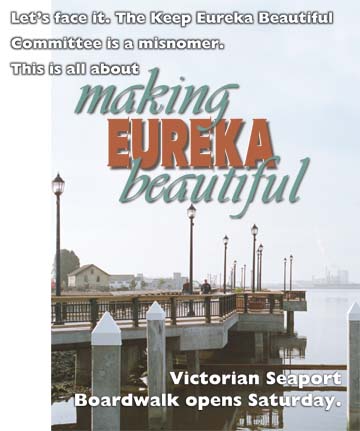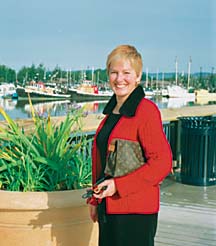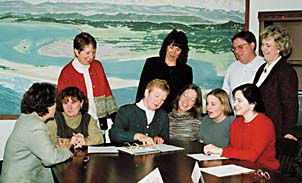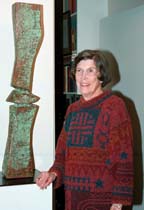|
 

Story by TERRY KRAMER
Photos by MARILYN ROTHÉ
WHEN THE CITY OF EUREKA UNVEILS
ITS QUARTER-MILE-long, $7.9 million boardwalk Saturday, it will
be a major leap in the city's evolution toward becoming a spruced-up
Victorian seaport sparkling with pride.
 The
boardwalk, stretching from the foot of C Street to G Street,
features a tree-lined public plaza at the foot of F, complete
with benches, large containerized plantings, flagpoles and a
45-foot mast with signal flags. Imbedded in the center is a compass
rose 28 feet in diameter made of tinted, stamped concrete with
inlaid brass and tiles. It is more than decoration. It is a statement.
[photo below left] The
boardwalk, stretching from the foot of C Street to G Street,
features a tree-lined public plaza at the foot of F, complete
with benches, large containerized plantings, flagpoles and a
45-foot mast with signal flags. Imbedded in the center is a compass
rose 28 feet in diameter made of tinted, stamped concrete with
inlaid brass and tiles. It is more than decoration. It is a statement.
[photo below left]
To Mayor Nancy Flemming [photo at right],
who has become a political juggernaut in Eureka's beautification
community during her 12-year tenure, the compass rose symbolizes
the essence of what the city is trying to achieve.
"The compass rose not only
shows you what true north is, but it also sets direction on all
maps. It is an important part of any nautical history. It is
very, very important to help find your way, so we think it is
a good symbol for the city of Eureka in showing that this is
the way. It is really going back to our heritage and celebrating
that we are a Victorian seaport. It is an inherent part of what
we are," Flemming said during a preview tour in mid-December.
![[photo of worker and compass rose]](cover0103-compassrose.jpg) The genesis of the boardwalk
project was more than a decade ago. In fact in 1990 when Flemming
was first elected mayor --53 percent of the vote in the primary
running against five opponents -- she ran on a platform of waterfront
redevelopment. The genesis of the boardwalk
project was more than a decade ago. In fact in 1990 when Flemming
was first elected mayor --53 percent of the vote in the primary
running against five opponents -- she ran on a platform of waterfront
redevelopment.
"I want a very functional
waterfront. I want it to be busy and active with people and certainly
the walkway will tie all those things together," she told
the Journal in a July interview that year.
The boardwalk, actually made
of concrete, became an integral part of the city's waterfront
revitalization plan adopted in 1993. Next came the planning,
permitting and pre-construction phase, jumping through the regulatory
hoops of overlapping jurisdictions. Finally, finding the funding
made the project a reality.
City leaders thought they had
financing in place in the fall of 2000 when the boardwalk construction
was put out to bid. About $4.5 million had been secured from
the California Coastal Conservancy, the Eureka Redevelopment
Agency and the Tidelands Trust Fund. An extra $1.7 million was
borrowed from a city wastewater reserve fund just in case. But
all the money together was not enough to fulfill Eureka's dream
of a full-fledged boardwalk. When bids were opened in November,
the lowest figure was $2 million more than the engineer's estimate.
That's when businessman Rob
Arkley and his wife, Councilmember Cherie Arkley, stepped forward
with an offer to make up the difference and get the project under
construction.
"My husband Rob and I gave
it to the city because they fell short of their estimate,"
said Cherie Arkley, who had to recuse herself from voting to
accept the money. "Unless the city had that extra $2 million,
the project would be dead."
Flemming agreed. "That
money enabled us to build the boardwalk all the way down to the
commercial fisherman's area [C Street]," she said. Without
the Arkleys' gift, the funds available would only have been enough
to build the central plaza on F Street.
While many are giving credit
to the Arkleys for their generosity, Arkley points to Flemming.
"It was Nancy Flemming's
vision to bring people back to the waterfront. She really has
spearheaded this ever since she [took] office," Arkley said.
![[photo of boardwalk]](cover0103-boardwalk.jpg)
The Boardwalk
![[photo of McKeegan and Arkley]](cover0103-michellesheri.jpg)
Michele McKeegan, president
of the beautification committee (left) and Councilmember Cherie
Arkley.
![[photo of man sitting on bench on the boardwalk]](cover0103-bench.jpg) ![[photo of two men planting trees]](cover0103-trees.jpg)
Left: Benches on boardwalk.
Right: tree planting, on city streets and slong the new boardwalk,
is a major focus of Keep Eureka Beautiful Committee's efforts.
While the boardwalk is probably
the most visible project to date in Eureka's efforts to beautify
itself, it is far from the only one. And leading those efforts
is a council-appointed advisory group that calls itself the "Keep
Eureka Beautiful" committee.
The 15-member panel, nicknamed
the KEB, was founded in 1996; its mission was to build civic
pride. The committee collaborates with many other community organizations
like the city's Design Review Committee, Humboldt Heritage Society,
Eureka Main Street Program and Eureka Chamber of Commerce. But
one of its critical functions is to advise and support the City
Council in enforcing its own landscape ordinance.
"They (KEB) are a very
respected group. The city listens to them," said Arkley.
"KEB goes before the council all the time and they give
awards of merit to different business owners around town who
pay special attention to beautifying their place. It's just a
wonderful group."
Michele McKeegan, president
of KEB and one of its founders, acknowledged that one of the
group's main duties is moral support for city staff. Sometimes,
she said, the city needs help encouraging property owners to
pay attention to cleaning up and "streetscaping" areas
surrounding existing buildings and enforcing the city ordinance
that sets rules for landscaping new construction.
"With the city, a lot of
it is just helping them do what they already want to do in terms
of enforcing the landscape ordinance." McKeegan said. "They
want to enforce it, but there are a lot of people pulling at
them not to do the right thing, like `I want more parking. I
don't want landscaping.' There is a lot of pressure on the city
not to do the right thing. So I think a lot of what we do is
give the city a little support."
  The
Keep Eureka Beautiful Committee: Front row from left, Elizabeth
Murguia, Liz Pierson, Michele McKeegan, Lynne Page, Kari Neibel,
Charlene Citler-Ploss. Back row, Sue Clinesmith, Stormi Bettiga,
Tom Coyle ande Marge Crichton. Elizabeth Anderson in in photo
at right. The
Keep Eureka Beautiful Committee: Front row from left, Elizabeth
Murguia, Liz Pierson, Michele McKeegan, Lynne Page, Kari Neibel,
Charlene Citler-Ploss. Back row, Sue Clinesmith, Stormi Bettiga,
Tom Coyle ande Marge Crichton. Elizabeth Anderson in in photo
at right.
In addition to the boardwalk
landscaping advice, over the last two years the KEB has been
involved in two other very visible horticultural feats --both
involve palm trees. First was landscaping the new county jail,
part of the Humboldt County Courthouse complex.
Controversial as the jail's
palm trees are -- people either hate or love the tropical flora
-- it is landscape in the finest Victorian tradition, says KEB
member Liz Pierson, owner with her husband Bill of Pierson's
Building Supply.
Pierson is the one who originally
came up with the idea of using palm trees to landscape certain
areas in Eureka. Palm trees, she said, fit in naturally with
the Victorian landscaping theme that both KEB and the city have
in mind.
"Eureka really does represent
palm trees. That's what the early Victorians planted," she
explained. Palms were often barged up here and planted in front
of Victorian homes as a status symbol.
A look around Eureka reveals
a number of well-established large Canary Island date palms,
Phoenix canariensis, in local parks and gracing old Victorian
homes. The palm trees around the courthouse are actually Mexican
fan palms, Washingtonia robusta. While not authentically
Victorian Canary Island date palms, Mexican fan palms were chosen
because they were economical, hardy and meet specific standards
for a city street tree.
And while they may look a little
out of place, they are historically a correct fit for Eureka,
Pierson said.
"Palm trees might not make
sense in a redwood forest or outside the city limits. But in
a city that is totally made up and impacted by man, they do,"
Pierson said. "The very first trees brought into Eureka
were palm trees, once they started to civilize the area and make
it into a city. We can deny that heritage, but it is there."
But how were the trees chosen
for the remodeled and expanded courthouse? First, plans were
drawn up by landscape designer Mary Gearheart, who donated her
services to the county. Then the plan went to both city and county
officials for approval -- with hardy encouragement from KEB.
"I had already convinced
[4th District Supervisor] Bonnie Neely," Pierson said. "At
that time she was on KEB, and so she thought it was a pretty
great idea.
"Basically, the guys in
the county said they could care less. They had no idea about
what the landscaping should be. They were getting hell from everybody.
They knew they had to plant something."
So the lobbying began, which
basically consisted of educating decision-makers about the notion
of what a Victorian landscape means, "the kind of landscaping
you need to make Eureka a Victorian seaport," Pierson said.
Former Councilwoman Connie Miller
was also on the committee and was committed to the project. Once
the city was agreeable, "It was pretty easy to get the county
to go for it. Everybody said, `Sure, whatever,'" Pierson
said.
Prior to the "palming"
of the courthouse, Pierson and KEB were busy encouraging Broadway
Cinema owner David Phillips to landscape the art deco style building
and massive parking lot with palm trees. It was a major victory
for KEB, Arkley said.
"KEB has to take complete
credit for (landscaping) all the concrete in front of the Broadway
Cinema. KEB said, `Let's have some landscaping,' and to his endless
credit, David did it. He put up all those palm trees, which was
terribly expensive."
Phillips later was rewarded
with a bronze plaque, a KEB award of merit.
Each year KEB rewards about
a half-dozen other businesses and individuals who go the extra
mile to beautify the city with a plaque. The awards are presented
at City Council meetings and recipients receive local media coverage.
Ultimately the bronze plaques become a part of beautification
itself since most become attached to buildings throughout the
city.
While some KEB victories are
obvious, others sometimes go unnoticed. The committee works hard
behinds the scenes to reduce the proliferation of billboards.
Recently the committee halted new construction of one billboard
and had four others removed.
"We prevented one gigantic
billboard from going in at the south end of town," said
McKeegan. "It would have been 32 feet high mounted, 48 feet
wide and 14 feet high -- double-faced and illuminated. It would
have been the Goliath of billboards. And so we fought that. It
was the first time that anybody had succeeded in opposing a billboard
around here. That was our first one.
"The second one was about
six months ago. The city lease came up for a billboard at Henderson
and Broadway and three [others] at the south end of town. We
went to the city and said `We don't want you to renew these leases.'
They voted not to renew. So that's part of what we do. Jump in
when we see an opportunity and take it," McKeegan said.
But KEB also loses some battles.
The group was particularly unhappy about a large advertising
sign that went up at the corner of West and Myrtle avenues in
a strip mall. The looming sign had a busy cluttered look that
KEB found noisome, but the city's Design Review Committee rejected
the committee's request that the sign be altered.
"Sometimes we don't win,"
said McKeegan.
![[photo of jail with palm trees]](cover0103-jailpalms.jpg) The palm trees in front
of the Humboldt County jail in Eureka. The palm trees in front
of the Humboldt County jail in Eureka.
There is a precedent for KEB's
attempts to improve the looks of the sprawling lumber/fishing
town of Eureka. Efforts at city beautification were launched
in the late 1950s when a volunteer group formed to encourage
the city to clean up and plant trees. Elizabeth Anderson, widow
of beautification pioneer Dr. Richard Anderson, remembers there
was a lot less to "keep" beautiful when the couple
first came to town.
"In 1953 it was the dingiest
place, the ugliest place I ever saw," she said. "Every
store front was just what you would expect of a lumber town.
Nobody cared about how things looked. There were no trees and
I thought we had come to the land of the big trees."
Along with other community members,
Dr. Anderson formed a beautification committee and got the city
of Eureka to proclaim it as part of the city. Planting trees
topped the agenda.
"It was either in the late
'50s or early '60s," Elizabeth Anderson recalled. "The
city raised the funds to plant trees and drill holes in the sidewalks.
They managed to get the trees planted on 5th Street." Beautification
had begun.
Community members planted flowers
around the trees and the committee gave out awards. "They
just gave pieces of paper and a little publicity. The recipients
went down to the mayor's office where he presented the awards,"
Anderson said.
It was a chain reaction: After
trees and flowers went in on public property, it encouraged Eurekans
to landscape and paint their homes and businesses, Anderson recalled.
The biggest accomplishment "was just making people conscious
of what a difference a bunch of trees and some plantings about
the base made. A lot of people, especially owners on H and I
streets, spruced up their dwellings."
While the town didn't get a
complete facelift, the attention was enough to make the town
look noticeably better. The committee lasted until about 1973
when it folded.
![[Eureka Boardwalk sign]](cover0103-egretsign.jpg)
While planting trees is part
of the history of Eureka beautification, it is also key to the
city's future appearance. Both the city of Eureka and KEB have
plans in the hopper to landscape the north and south ends of
town and the Broadway corridor with trees as well. The KEB has
drafted a resolution to go before the City Council in January
that envisions Eureka as a tree-lined city. The plantings could
become a sort of panacea for an increasingly urban Eureka, says
McKeegan.
"You know, if we have big
trees on our streets that means that people are more likely to
walk on these streets and enjoy them. More people on the streets
means they are safer. It means that there is less litter,"
McKeegan said.
"Big trees slow down traffic
because it makes the street feel narrower, which means kids can
ride on their bikes to school. People start doing up their front
yards and making things nice, instead of throwing up walls. For
me that's what it is all about. It is a sense of community. People
need to understand that beautification is not just a fill-up.
It's not an extra added thing you can have or not have. It really
is essential."
Arguments like McKeegan's bring
beautification out of the realm of aesthetics and into the world
of economic development -- and those arguments are shared by
others.
Landscaping with trees, cleaning
up the streets and painting buildings are essentials that make
a city a desirable place to live and to do business, said Mayor
Flemming.
"I think there is now a
respect for beautification as a word in itself. I think the city
of Eureka is very much like a person. We want Eureka to have
a real sense of identity," she said.
And what might that identity
be?
"A Victorian seaport,"
Flemming said. "That ends all barriers. There isn't an Old
Town, a Downtown, a Henderson Center. We are all those sections,
but we are also one incredible Victorian seaport. And I think
when you focus on cleaning up, fixing up, as we have with all
of our programs, then you have a city dressed for its interview.
"That is economic development.
You have to look like you are proud and that you have something
to offer," she said.
And standing in front of the
compass rose on the newly completed boardwalk, preparing to hoist
a symbolic ship's lantern during opening ceremonies Saturday,
Flemming is a very visible example of that pride.
WANT
TO GO DOWN in history? Saturday, Jan. 5, is your chance.
A community photograph will be taken of all attendees at the
dedication ceremony of the new Eureka Boardwalk Saturday, Jan.
5, at 4 p.m. The location is the new F Street Plaza on the waterfront.
Speakers will include Mayor
Nancy Flemming and state Sen. Wesley Chesbro. There will be performances
by singer Donna Landry, the Eureka High School Jazz Band and
Eureka High NJROTC. The city fire boat and the Coast Guard ship
Barracuda will patrol the waters.
The highlight of the ceremony
will be the hoisting of a ship's lantern up the new flag-staff
and lighting each street lamp one at a time along the new walkway
from G to C streets.
At the conclusion of the
dedication, Eureka Main Street will begin its monthly arts walk,
Arts Alive!, through Old Town and downtown. Arts Alive! venues
will be open until 9 p.m. (See Arts Alive!
schedule.) For more information regarding dedication events,
call 441-4144.
IN
THE NEWS | ARTS ALIVE! | CALENDAR
Comments? E-mail the Journal: ncjour@northcoast.com

© Copyright 2002, North Coast Journal,
Inc.
|